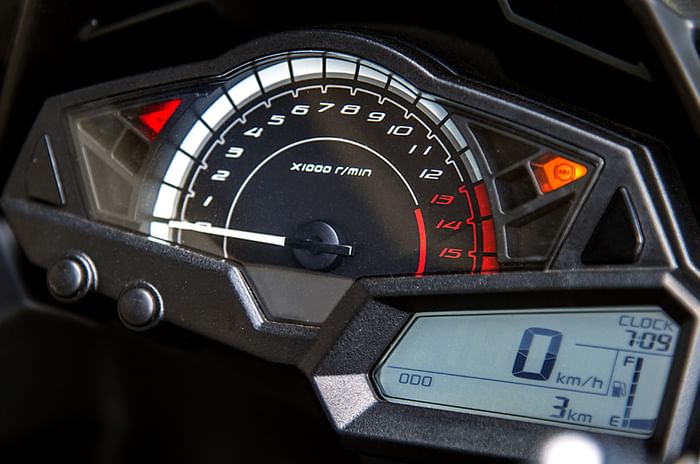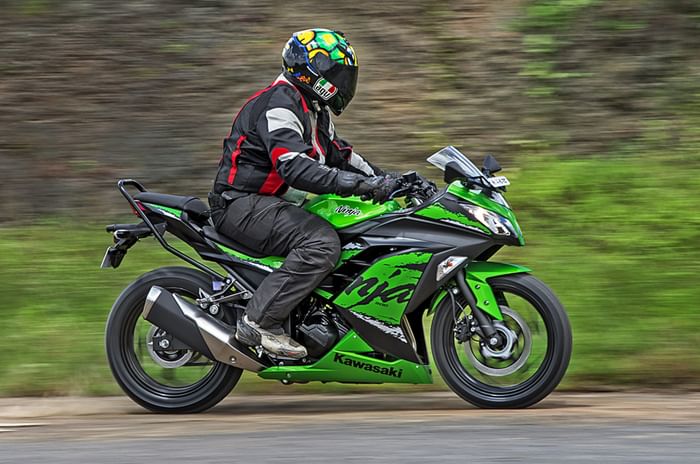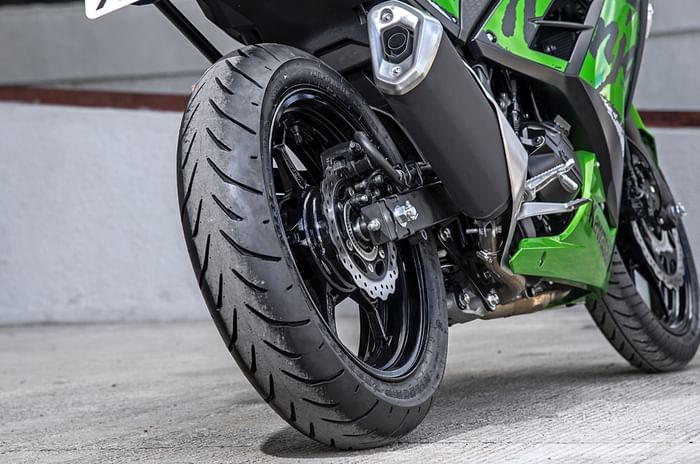With the Ninja 400 coming into the picture, it seemed like the Ninja 300 would face the axe – and it did in most markets, but not in India. The exception was made on account of the Ninja 400’s pricing, which makes it unapproachable for many, also bringing it uncomfortably close to the Z650 for those who can afford it. Kawasaki saw this as an opportunity to make its first attempt at localised manufacturing and, as a result, the baby Ninja is now the most affordable twin-cylinder bike on sale in India. Only one question remained – would the lower price tag come with a similar reduction in quality as well? We found the answer over a quick ride.

New graphics make the 2018 Ninja 300 look distinctive.
LOCAL FLAVOURS
Despite the addition of ABS, the new Ninja 300 is more affordable than the older bike by a massive Rs 62,000. Kawasaki managed this by turning to local sourcing for the panels, tyres, wheels, wiring and brakes. The bike we rode was literally fresh off the line, but we were glad to see that none of the panels rattled and that fit and finish levels are similar to the older bike. However, it still remains to be seen if this level of quality can sustain the test of time, especially on our roads.

Semi-digital instrument console has been carried forward.
The baby Ninja’s chassis and engine continue to remain CKD imports, and in terms of mechanicals and styling, it remains identical. However, the new motorcycle features redesigned graphics and new colour options (green and blue) to distinguish itself from the older bike. While the new graphics are snazzier, I prefer the older KRT graphics; the crude grab rail continues to be an eyesore, though. The semi-digital instrument cluster has been carried forward, with the large analogue tachometer taking centre stage.Despite its age, the Ninja 300 still remains a visually appealing machine with its sharp lines and sizeable proportions, which is one of the prime reasons for its popularity in India.
ON THE ROAD
Within the fairing sits the same 296cc, liquid-cooled motor as seen on the older bike. The parallel-twin engine produces 39hp, almost of all of which is concentrated at the top, and 27Nm of torque, which makes it feel very calm and docile at lower rpm. The motor comes to life at around 5,000rpm and the power band kicks in by 8,000rpm. While the Ninja 300 might not be the quickest accelerating bike in its segment, going by sensations, it surely isn’t too far behind its rivals.

Refinement and easy power delivery remains a highlight of the twin-cylinder motor.
What will really grab your attention is the refinement of the high-revving powerplant. Only near the redline, can a few vibes be felt through the handlebars. This refined nature also makes touring on the bike a fairly stress-free affair. You can cruise at triple-digit speeds effortlessly, with the motor spinning around 7,000rpm. However, a bit of mid-range grunt would have been welcome as you have to downshift and wring the throttle to execute overtakes. On the plus side, you can lazily hold higher gears at low traffic speeds and the engine does not protest. Another impressive bit of kit is the 6-speed gearbox that offers slick and precise gear shifts. The slipper clutch is decently effective and the light-action assist reduces fatigue in traffic. The comfy riding position and 785mm seat height will appeal to riders of all sizes.
The Ninja 300 retains its competent handling characteristics despite being 7kg heavier. It tips into corners easily and holds its line with ease. Alright, so it isn’t as sharp as the KTM RC 390 or even the new Ninja 400; but it’s still a bike that can keep the rider well-entertained. The new MRF Nylogrip Zappers offer more grip and feel than the older IRC tyres but aggressive riders will be better off investing in more expensive rubber. Braking hardware has been sourced from Endurance and it sheds speeds well, while the inclusion of dual-channel ABS is a positive move. Ride quality continues to be good and the bike absorbs undulations and broken roads with little effort. However, sharp bumps do unsettle the bike a bit.

MRF tyres are a fair replacement for the IRC tyres.
FINAL CALL
The Kawasaki Ninja 300 has always been a well-rounded product and the Rs 2.98 lakh (ex-showroom) price tag, in addition to ABS, has added impressively to its value. Quality hasn’t been noticeably affected and the only aspects to consider are the relatively small dealer network and Kawasaki’s typically high service and ownership costs. However, if you are in the hunt for an entry-level twin-cylinder sports bike, the 2018 Ninja 300 is a very tempting option, indeed.















































